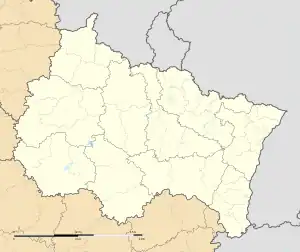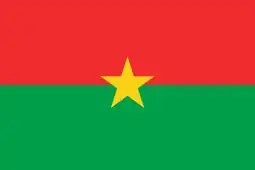Épernay | |
|---|---|
Subprefecture and commune | |
 Vineyards near Épernay | |
 Coat of arms | |
Location of Épernay | |
 Épernay  Épernay | |
| Coordinates: 49°02′25″N 3°57′36″E / 49.0403°N 3.96°E | |
| Country | France |
| Region | Grand Est |
| Department | Marne |
| Arrondissement | Épernay |
| Canton | Épernay-1 and 2 |
| Intercommunality | CA Épernay, Coteaux et Plaine de Champagne |
| Government | |
| • Mayor (2023–2026) | Christine Mazy[1] |
| Area 1 | 22.69 km2 (8.76 sq mi) |
| Population | 22,001 |
| • Density | 970/km2 (2,500/sq mi) |
| Time zone | UTC+01:00 (CET) |
| • Summer (DST) | UTC+02:00 (CEST) |
| INSEE/Postal code | 51230 /51200 |
| 1 French Land Register data, which excludes lakes, ponds, glaciers > 1 km2 (0.386 sq mi or 247 acres) and river estuaries. | |
Épernay (French pronunciation: [epɛʁnɛ]) is a commune in the Marne department of northern France,[3] 130 km north-east of Paris on the mainline railway to Strasbourg. The town sits on the left bank of the Marne at the extremity of the Cubry valley which crosses it.[4]
Épernay is a sub-prefecture of the department and seat of an arrondissement.[3]
History
Épernay (Sparnacum) belonged to the archbishops of Reims from the 5th until the 10th century, when it came into the possession of the counts of Champagne. It was badly damaged during the Hundred Years' War, and was burned by Francis I in 1544. It resisted Henry of Navarre in 1592, and Marshal Biron fell in the attack which preceded its eventual capture. In 1642 it was, along with Château-Thierry, named as a duchy and assigned to the duc de Bouillon.[4]
Population
|
| ||||||||||||||||||||||||||||||||||||||||||||||||||||||||||||||||||||||||||||||||||||||||||||||||||||||||||||||||||
| Source: EHESS[5] and INSEE (1968-2017)[6] | |||||||||||||||||||||||||||||||||||||||||||||||||||||||||||||||||||||||||||||||||||||||||||||||||||||||||||||||||||
Main sights
In the central and oldest quarter of the town, the streets are narrow and irregular; the surrounding suburbs, however, are modern and more spacious, with La Folie to the East, for example, containing many villas belonging to rich wine merchants. The town has also spread to the right bank of the Marne.[4]
One of its churches retains a portal and stained-glass windows from the sixteenth century, but the other public buildings are of modern construction.[4] The most famous street in Épernay is the Avenue de Champagne which features the leading Champagne manufacturers.
Other sights outside the town include:
- Château de Pierry
- Château de Montmort
- Château de Condé
Economy
Épernay is best known as the principal "entrepôt" for champagne wines, which are bottled and kept in large cellars built into the chalk rock on which the town is built. The major grape varieties used in champagne are the pinot noir, the pinot meunier and the chardonnay.[7] The production of the equipment and raw materials used in the champagne industry is a major source of local employment. Champagne Pannier, among others, was established in Épernay before moving to Château-Thierry in 1937. Brewing and sugar refinery and the production of hats and caps, are also major industries.[4]
Épernay station has rail connections to Paris, Strasbourg, Reims, Metz, Nancy and several regional destinations.

Notable people
Épernay was the birthplace of:
- Flodoard (894–966), chronicler
- Maakan Tounkara, handball player
- Henri-Gustave Joly de Lotbinière, Québécois politician
- Gabrielle Dorziat, comedian
- Yohann Diniz, athlete
- John Gadret, cyclist
- Léon Homo (1872–1957), historian
- Jean-Baptiste-Maximien Parchappe de Vinay (1800–1866), psychiatrist
- Alex Vanopslagh, Danish politician
Épernay was the final resting place of:
- Léon Azéma (1888–1978), French architect, died in Épernay and is buried in the cemetery there.
- Yvette Lundy (1916–2019), member of the French Resistance.[8]
Twin towns — sister cities
 Ettlingen, Germany
Ettlingen, Germany Clevedon, England, United Kingdom
Clevedon, England, United Kingdom Fada N'gourma, Burkina Faso
Fada N'gourma, Burkina Faso.svg.png.webp) Middelkerke, Belgium
Middelkerke, Belgium Montespertoli, Italy
Montespertoli, Italy
See also
References
- ↑ "Répertoire national des élus: les maires" (in French). data.gouv.fr, Plateforme ouverte des données publiques françaises. 6 June 2023.
- ↑ "Populations légales 2021". The National Institute of Statistics and Economic Studies. 28 December 2023.
- 1 2 INSEE commune file
- 1 2 3 4 5 Chisholm 1911.
- ↑ Des villages de Cassini aux communes d'aujourd'hui: Commune data sheet Épernay, EHESS (in French).
- ↑ Population en historique depuis 1968, INSEE
- ↑ Simpson, James (16 October 2011). Creating Wine: The Emergence of a World Industry, 1840-1914. Princeton: Princeton University Press. p. 134. ISBN 978-0-691-13603-5. Retrieved 11 February 2022.
- ↑ "'Great lady of the French Resistance' dies at 103". 3 November 2019 – via www.bbc.co.uk.
- ↑ "Villes jumelées". epernay.fr (in French). Épernay. Retrieved 21 November 2019.
- This article incorporates text from a publication now in the public domain: Chisholm, Hugh, ed. (1911). "Épernay". Encyclopædia Britannica. Vol. 9 (11th ed.). Cambridge University Press. p. 669.
External links
- Official website (in French)